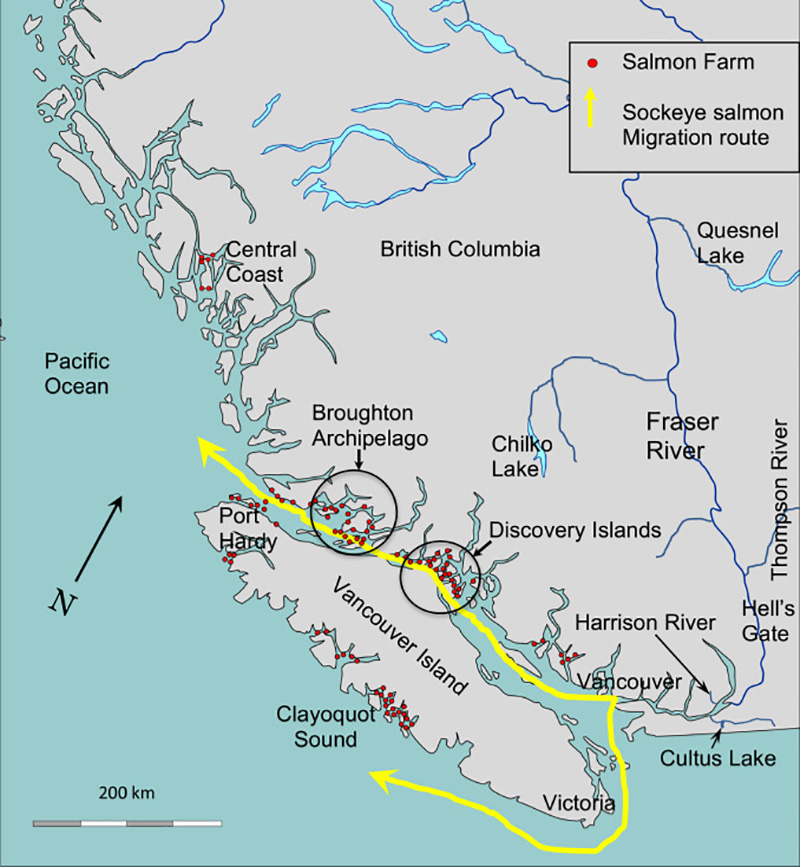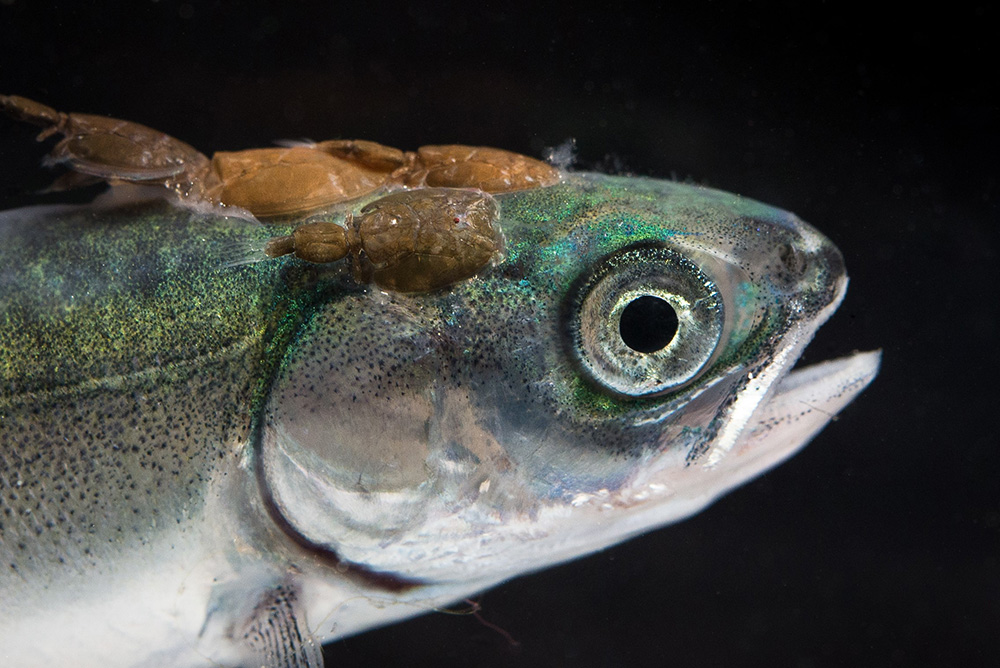[Editor’s note: Andrew Nikiforuk filed this breaking news update on the afternoon of Dec. 17, updating this piece published early in the morning.]
Acting on the wishes of seven First Nations in the Discovery Islands DFO Minister Bernadette Jordan has not renewed fish farm licenses in the Discovery Islands but ordered the phase out of all 19 Atlantic salmon feedlots owned by Norwegian-based companies. That means juvenile salmon will not have run through a gauntlet of fish farms and their parasites along one of the province’s largest wild salmon migration routes.
All the farms are to be emptied of Atlantic salmon by June 30, 2021.
“This is the culmination of a long fight,” said Alex Morton, an independent biologist and researcher who first identified the threat posed by sea lice infestations on farms to wild fish 20 years ago. “For the first time since 1991, when sockeye runs started to decline, Okisollo Channel will be free of fish farms. They have blocked a critical artery for the movement of wild fish for far too long.”
Mowi, the world’s largest producer of farmed Atlantic salmon, will lose 14 farms while Cermaq will loose two. The last facility belongs to Grieg Seafood.
Bob Chamberlain, the chief of the First Nations Wild Salmon Alliance who negotiated on behalf of three of the seven First Nations with DFO, called the minister’s decision to close the farms a welcome one. “It is a step in the right direction toward protecting wild salmon but there are many more steps to be taken.” Those steps include habitat restoration and the return of salmon governance to First Nations.
Chamberlain says 102 First Nations up and down B.C.'s coast want to see fish farms out of the ocean to help stop the downward spiral of extinction of wild Pacific salmon. The nations that spoke up for the rights of wild salmon and pressured the minister to act are Homalco First Nation, Klahoose, Komoks, Kwiakah, Tla’amin, We Wai Kai (Cape Mudge) and Wei Wai Kum (Campbell River) First Nations in the region.
Here is the piece we published earlier today:
Three decisions may well seal the fate of wild Pacific salmon along the coast of British Columbia this year.
The first was the Department of Fisheries and Oceans’ decision to essentially legalize high sea lice infestations on fish farms for periods of time last spring.
The second was DFO’s calculated response to the Cohen Commission’s recommendations that fish farming must end by Sept. 30, 2020 in the Discovery Islands unless the federal fisheries minister can show that they cause less than minimal risk to migrating juvenile Fraser River sockeye salmon. Minister Bernadette Jordan said that there was no real risk.
The third decision is said to be imminent. Will the government renew federal licenses for 18 industrial Atlantic salmon feedlots in the Discovery Islands when they expire this week?
What the government decides could well determine the future of the wild Pacific salmon as well as the fate of their invasive Atlantic cousins raised on intensive farmed systems located along the historic migration routes of wild fish.
Many species of wild Pacific salmon (including sockeye), the miraculous fish that have energized B.C.’s rain forests for millennia, have now reached their lowest numbers in recorded history.
Meanwhile farmed Atlantic salmon, the industrial product of three Norwegian-based corporations, are in the process of losing 17 industrial feedlots in the Broughton Archipelago due a powerful assertion of Indigenous sovereignty.
The industry now faces the prospect of a federal announcement that there will be transition from open-net systems to land-based farming by 2025 due to disease, sea lice and pollution issues.
Will DFO Minister Jordan now renew the 18 salmon-farm licenses in the Discovery Islands? Or will the government remove the seven million farmed salmon now raised in feedlots in those waters in response to what is arguably a biological collision course with remaining wild sockeye stocks?
1. The decision to legalize high lice infestations
Let’s deal with the first decision on sea lice. Last March DFO granted corporate fish farms permission to exceed B.C.’s lice threshold (three per fish) for 42 days with impunity.
Sea lice are the costly bane of farmed Atlantic salmon feedlots because unnatural overcrowding allows the parasite to explode in unnaturally huge numbers.
European research has shown that sea lice can, over successive annual outbreaks, dramatically reduce the population health of wild fish stocks.
For years now DFO has passively watched massive epidemics of sea lice devastate wild juvenile runs of Pacific salmon because the agency had no enforceable regulations built into the conditions of licenses granted to Norwegian companies.
The government only required that foreign-owned corporations show they had “a plan” for treatment such as pesticides or delousing technology but not a plan to actually reduce lice plagues that overwhelm and kill young migrating wild fish.
Last year former fisheries minister Jonathan Wilkinson even sent a letter pleading with one company, Cermaq, to get its lice situation under control.
The government refused to release the full letter, claiming “it is confidential correspondence between the Department and a business organization.”
But instead of responding to their own field staff by issuing a hard sea lice cut-off with threat of penalties, the DFO chose to simply legalize high lice infestation rates for 42 days every time sea lice levels rose above three adult lice per farm salmon.
The 42-day period, which represents one third of the migratory period for young salmon, is also repeatable.
In other words a company can temporarily reduce levels to the three lice threshold only to witness another explosion whereby they are granted another 42 day grace period to get their lice under control.
The effect of this practice, says researcher and author Alex Morton, is that there is no real enforcement on sea lice. “Every time they go over the threshold considered safe, the industry is granted another 42 days to have unlimited number of sea lice,” said Morton.

Last summer 14 corporate facilities reported lice infestation well above the DFO threshold. (Companies often under-report sea lice plagues.)
Mowi (formerly Marine Harvest) reported infection rates of 20 lice per fish in Johnstone Strait while Grieg Seafood issued a public apology for runaway infections in Nootka Sound: “The most unfortunate part of this lice outbreak is its timing, which was during the outmigration of wild juvenile salmon.”
In many cases companies reduced the levels briefly with mechanical or chemical treatment only for sea lice levels to rebound and again exceed the limit threatening wild salmon.
As climate change warms the oceans more, sea lice infestations are expected to worsen.
According to research by Morton, 99 per cent of sockeye were infected with an average of nine sea lice in the Discovery Islands last spring.
2. The decision to downplay lice effects on Pacific salmon
The second decision arrived this September.
After its investigation into the decline of Fraser River sockeye the Cohen Commission made 75 recommendations. One stipulated that fish farms in the Discovery Islands be removed if they cause greater than minimal risk to migrating Fraser River sockeye salmon.
DFO posted its response to that recommendation in September. After conducting 9 assessments of pathogens issuing from fish farms it concluded the following:
“All of the assessments concluded that the pathogens on Atlantic salmon farms in the Discovery Islands area pose no more than a minimal risk to Fraser River sockeye salmon abundance and diversity under the current fish health management practices.”
DFO admitted sea lice were a concern but concluded that “Atlantic salmon are generally more susceptible to sea lice infestations than Pacific salmon species.”
Except that’s not what three DFO researchers concluded in a 2018 paper on sea lice that looked at the physiological impacts of one louse species on young wild sockeye compared to young farmed fish.
The study found that sea lice stressed out and destabilized the metabolism of Pacific sockeye much more than they did Atlantic salmon. Nine lice per fish could kill.
The overall impact of lice infections “on host physiology was noticeably greater in sockeye salmon.” In other words wild young fish were much “more susceptible” to sea lice infections.
3. The impending decision to leave open or close Discovery Islands fish farms
And now comes the third decision: whether or not to renew licenses for 18 corporate facilities located in the Discovery Islands where approximately one third of all B.C. wild salmon species migrate to and from the great Fraser and other rivers.
Although the federal government has consulted with seven First Nations in the Discovery Islands about the fate of these facilities, it has not consulted with Fraser River First Nations.
And they are angry. In a Dec. 3 letter to the DFO Minister Jordan, Chief Don Harris of the St’at’imc Nation expressed his disappointment in not being consulted by DFO. “Our culture, traditions, way-of-life and food security depends on the Fraser River wild salmon,” he reminded.
The letter explained that sea lice remained an unacceptable threat. “Through accepted ethical standards for scientific research using published methodology, a staggering amount of data was collected over a 20-year period, which conclude that sea lice infestations on juvenile wild salmon only occur when exposed to fish farms, thus, is a major contributing factor to the decline of the Fraser River sockeye."
Harris urged the federal minister “to repeal federal practices, processes and policies that are contributing to the collapse of the Fraser River wild salmon and to fully implement the Precautionary Principle in this matter as an available tool and a necessary step to safeguard the Fraser River wild salmon from becoming extinct.”
The Canadian Pension Fund, by the way, is the fifth largest investor in Mowi, one of the Norwegian companies active in the Discovery Islands.
And so the future of wild salmon, which naturally energize the rivers and forests of B.C., and the fate of farmed Atlantic salmon, the artificial product of industrial systems, appear to have reached a tipping point on the coast of British Columbia. ![]()
Read more: Food, Environment
















Tyee Commenting Guidelines
Comments that violate guidelines risk being deleted, and violations may result in a temporary or permanent user ban. Maintain the spirit of good conversation to stay in the discussion.
*Please note The Tyee is not a forum for spreading misinformation about COVID-19, denying its existence or minimizing its risk to public health.
Do:
Do not: